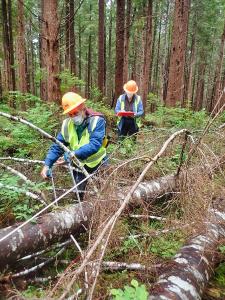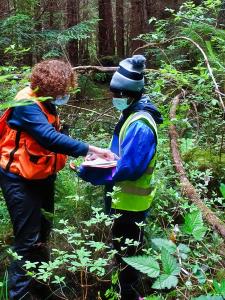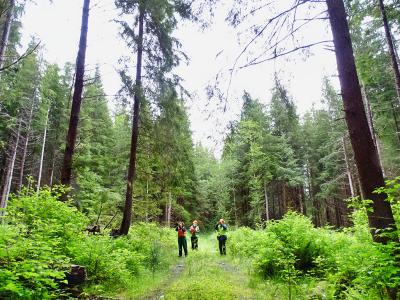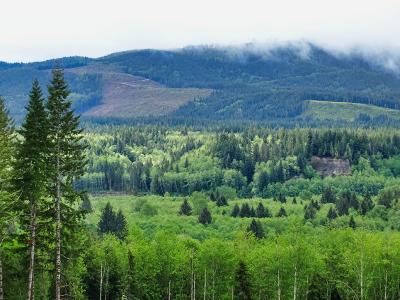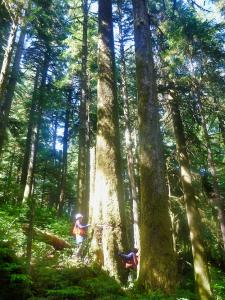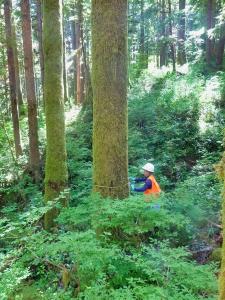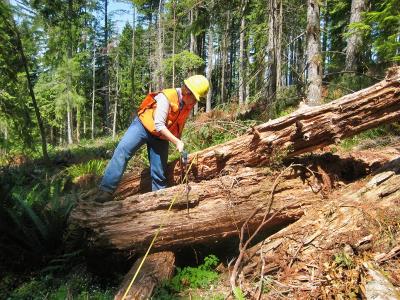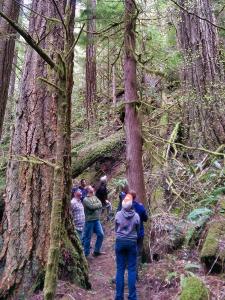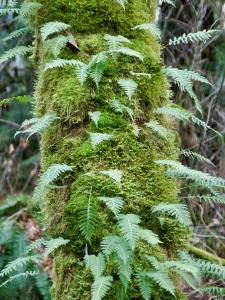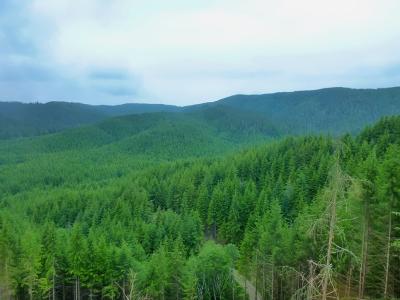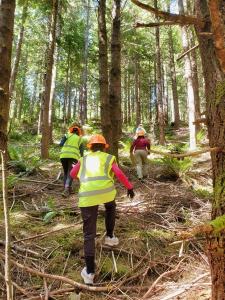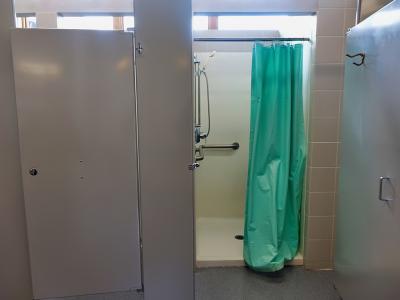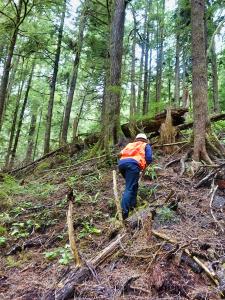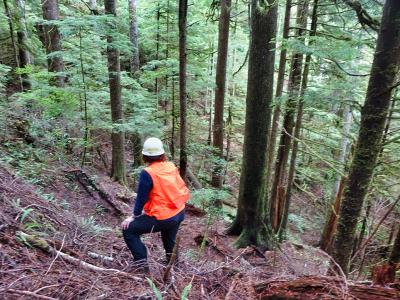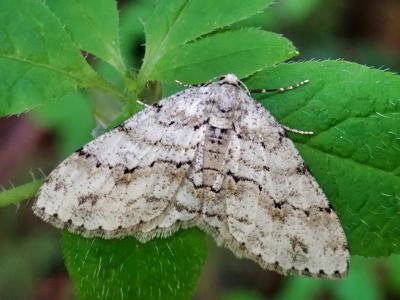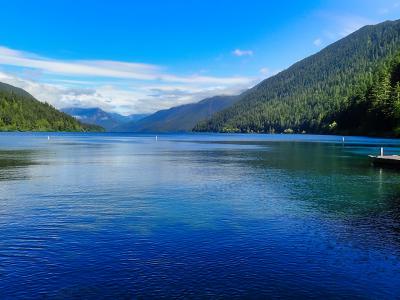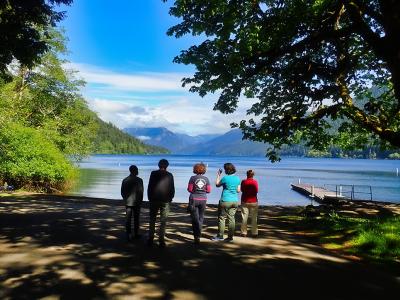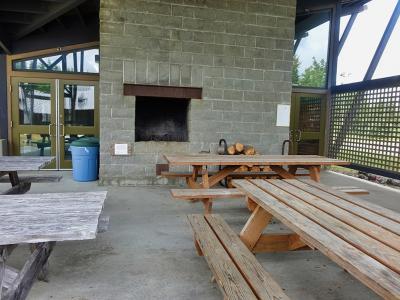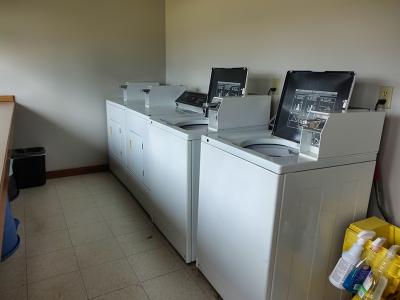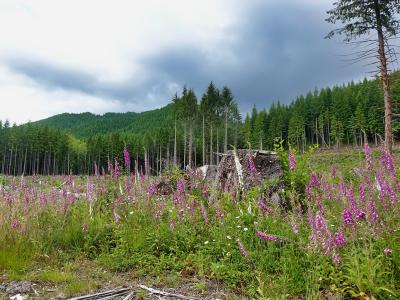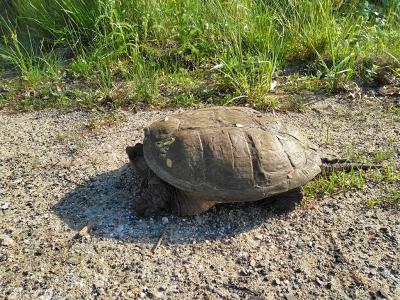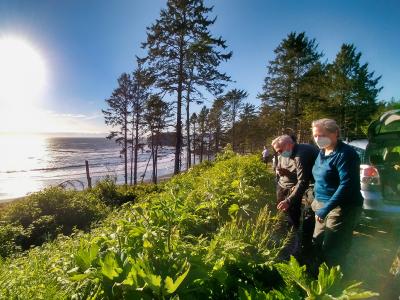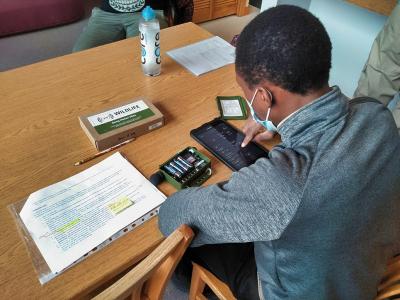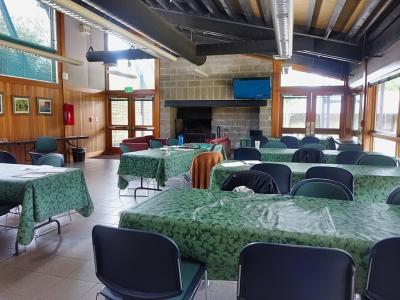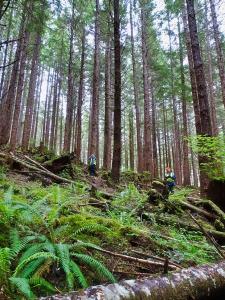.
.
Sustaining Forests, Biodiversity, and Livelihoods on Washington's Olympic Peninsula
Expedition Briefing
.
COVID-19 Enhanced Health and Safety Measures
This project has been amended to incorporate several health and safety measures to allow responsible fielding of teams during the COVID-19 pandemic. Please refer to the COVID Disclosure Form for more details.
Before Fielding
- Vaccination against COVID-19 is required for all participants. Staying up-to-date with your vaccinations, including receiving booster doses if available, is strongly encouraged.
- Become familiar with and abide by the local COVID requirements up to date vaccinations, including boosters, mandatory quarantine, or other guidelines.
- Do not travel to your Earthwatch expedition or program if you:
- are experiencing symptoms consistent with COVID-19 (cough, shortness of breath or difficulty breathing, fever, chills, muscle pain, sore throat, or new loss of taste or smell),
- are confirmed or suspected as having COVID-19 within the past 10 days
- have been in close contact with someone suspected or confirmed as having COVID-19 in the past 10 days
- You are highly encouraged to take a COVID-19 test one day before or the morning of your rendezvous, before meeting up with your team.
While in the Field
- Face masks will be required in line with local regulations and/or when instructed by project leadership. In areas or on projects where mask use is no longer required, the use of face masks will be optional. Any individual who wishes to continue to mask will be supported in that decision.
- Participants and project staff will continue to wash or sanitize hands frequently and maintain physical distance whenever possible.
- All team members will be asked to monitor their own health through daily health checks.
- Recreational activities may be limited or require additional face mask requirements in order to reduce the risk of exposure to team members or to the local community.
- Meals and activities will take place outside whenever possible.
- Ventilation will be increased indoors and within enclosed vehicles whenever possible.
The Research
Washington State’s region of the Olympic Peninsula is a historically, culturally, and ecologically unique place. From the towering old growth forests to the unimpeded rivers to the rugged mountains, this area provides important landscapes and habitats for a unique diversity of species. No less than 29 species or subspecies of mammal, birds, amphibians, and fish are only found on the Peninsula, and the area is home to multiple species listed under the Endangered Species Act. Eight Native American tribes call the Peninsula home, who maintain strong historical connections with the area and rely on the landscape for subsistence and culture. Additionally, almost one million acres of this woodland is protected as a World Heritage site, the Olympic National Park, which receives more than 3 million visitors every year.
This landscape is undeniably important to a variety of animals, scientists, and cultures, but preserving and maintaining the area is becoming more and more challenging. As humans expand their footprint on earth, managing forests sustainably will continue to be a pressing global problem. Traditional approaches to forest management tend to focus exclusively on ecological or revenue objectives, leaving out an important component: humans and their communities.
Concerns about the sustainable use of the resources within the Olympic Peninsula and the social, cultural, and economic consequences for the communities on the Peninsula have led the managers of the woodland to reevaluate their management strategies.
This project will test sustainable forest management strategies using a more comprehensive approach that includes not only ecological health, but also social and economic well-being of nearby communities. This ambitious long-term watershed-scale management experiment aims to identify strategies that lift the well-being of both human communities and forest ecosystems above current levels. Three forest management strategies and a no-action control will be implemented across watersheds in the Olympic Experimental State Forest (OESF), which is managed by the Washington Department of Natural Resources (WADNR) and is located adjacent to the Olympic National Park.
Social and community well-being indicators are being determined through a collaborative process, and will be used in conjunction with ecological outcomes to compare management strategies. The results will help WADNR and other land managers expand their management toolbox and improve their forest management practices.
Research Aims
The primary research question addressed by this project is: How does habitat quality, diversity, and function, as indicated by the occupancy rate of key bird species, change in response to different forest management practices?
To answer this question, this project will use sound recordings of indicator bird species to evaluate the habitat quality, function, and overall ecosystem integrity resulting from different approaches to active management of forests. The experiment will take place in 16 watersheds, spanning 32 square miles, within the Olympic Experimental State Forest (OESF), a state- managed land designated for the study of integrating timber harvesting and habitat conservation. The 16 watersheds are grouped into four blocks based on similarities in elevation, size, and forest age. Within each block, each watershed was assigned one of four management strategies: (1) “Plan,” which continues the current best forest management practices under habitat conservation strategies and sustainable timber harvest levels, (2) “Alternative-1 Integration,” which integrates current habitat mandates and action on ecological concerns, like restoration of riparian vegetation, with continued revenue generation. (3) “Alternative-2 Integration,” which focuses on community wellbeing concerns,such as preserving populations of culturally significant understory plant species, elk, and fish, by applying perspectives and traditional knowledge from diverse collaborators, and (4) “No-action control” under which there will be no management activities.
As birds are an integral part of the forest ecosystem, and excellent indicators of its change, studying which birds live where will give researchers key insights into the health and sustainability of different types of managed forests. Bird occupancy will be determined by collecting recordings of bird calls, known as passive acoustic monitoring (PAM). To capture these calls, volunteers will install sound recording devices in different locations within the experimental watersheds.
The recordings from these devices will then be run through an automated recognition software that can recognize calls from target species. Paired with habitat surveys, in which volunteers record tree species, measure tree diameters, and assess the understory vegetation, researchers will be able to determine what bird species are living in each type of forest and how bird occupancy is responding to different management styles. The ultimate goal of this study is to inform managers of the OESF and other state and federal lands how different forest management strategies impact both environmental and community wellbeing.
The project aims to answer the following questions:
- What are the differences in forest composition and stand structure among “ecosystem types” representing four stand developmental stages?
- What are the differences in forest composition and stand structure before and after treatment in each ecosystem?
- What are the differences in habitat function (as determined by occupancy rate of bird species) among “ecosystem types” representing different stand developmental stages?
- What are the differences in habitat function (as determined by occupancy rate of bird species) before and after treatment in each ecosystem?
The volunteers on this project will be participating in one of the first studies to use PAM in a large-scale experimental framework to test changes in response to different forest management strategies.
How You Will Help
Volunteers will travel to a remote and wild area of the Pacific Northwest to delve into the important consequences forest management has for the wildlife within it and the community around it. With your help, scientists will collect data that fill important gaps in knowledge on the intersections of conservation and forest management. Volunteers will spend most of their time in the field, experiencing the rich biodiversity of the Olympic Peninsula. As part of this team you will:
- Conduct Habitat Surveys: The main focus of this project will be to collect forest habitat data at each site with installed sound recording units. In four 255 m2 plots (spaced 40 m from the sound recording unit), you will identify tree species, measure tree diameters and height, measure down wood, and estimate the cover of understory plants.
- Service Sound Recording Units: While in the field, you will aid in installing, programming, launching, downloading data from, and deinstalling the acoustic monitoring recording units in different habitat types in multiple watersheds across the OESF.
- Manage and Process Data: The entire team will work together to organize data and do basic quality control. The sound recordings will be run through an automated recognition software that can recognize target species. Volunteers will be introduced to this process and may have opportunities to help process this data and confirm the results. All sound and habitat survey data will be compiled into master databases that each team will contribute to.
Important: This project is rated as one of our most physically strenuous projects. Please be sure to carefully review the Essential Eligibility Requirements section to determine if this expedition is the right fit for you. If you have any questions or concerns, please contact Earthwatch to speak with an Expedition Advisor.
Life in the Field
The field sites and the field station are located on the Western Olympic Peninsula in Washington State, USA. The area is full of lush temperate rain forest in steep, hilly terrain and the climate is very wet. You will be housed in comfortable accommodations about an hour from the field sites. Each day you will travel to the Olympic Experimental State Forest and hike to your field sites setting up acoustic monitoring equipment and doing habitat surveys. In the evenings we’ll have time for data downloads and management, lectures, or rest.
Your team will stay at a field education and research station called the Olympic Natural Resources Center (ONRC) operated by the University of Washington. It is located in the town of Forks, WA on Washington’s scenic Olympic Peninsula. The facility offers modern meeting and lodging facilities in a rustic, peaceful setting.
On one of the days and possibly some afternoons we will plan for a few recreational activities where you can explore the rich cultural and natural history of the Olympic Peninsula. These may include a trip to the Hoh rainforest, a beach hike and picnic, or hikes around the ONRC research station.
COVID-19 SAFETY MEASURES
- Participants are asked not to approach or speak with unfamiliar people not associated with the project to reduce the risk of disease transmission during the COVID-19 pandemic.
- Participants and project staff will maintain physical distance, wash/sanitize hands frequently, and wear face masks as instructed by project leadership.
- All team members will participate in daily health checks
- Recreation time will be limited to activities that can accommodate Earthwatch’s distancing and sanitation protocols. Unstructured exploration of public spaces and community interaction will not be possible at this time.
ITINERARY
Weather and research needs can lead to changes in the daily schedule. We appreciate your cooperation and understanding.
- Day 1: Arrival in the late afternoon, team dinner and project orientation.
- Day 2: Training at the research station that covers the use of field instruments, f plant species identification, and field procedures, followed by training in the field.
- Days 3–6:
- Data collection, fieldwork of paired acoustic monitoring and habitat surveys
- Data management and analysis
- Day 7: Recreation day
- Day 8: Team wrap-up and review of achievements, completion of outstanding data entry and departure.
Accommodations and Food
Accommodations and Food
Participants will stay at the Olympic Natural Resources Center (ONRC) (https://www.onrc.washington.edu/)
SLEEPING
Participants will be assigned private bedrooms at the ONRC. Couples rooms can be accommodated upon request. Bathroom facilities will be shared and separated by gender. Ample hand soap and cleaning supplies will be provided. Common areas and high-touch surfaces will be cleaned daily.
* Earthwatch will honor each person’s assertion of gender identity, respectfully and without judgment. For both teen and adult teams, where logistics dictate single-sex accommodations or other facilities, participant placements will be made in accordance with the gender identity the participant specified on their Earthwatch Participant form and/or preferences indicated in discussions with Earthwatch.
BATHROOMS
Bathroom facilities include hot showers and flush toilets.
ELECTRICITY
You are welcome to bring electrical equipment. There is electricity 24/7. All lodging facilities have standard US electrical outlets.
PERSONAL COMMUNICATIONS
Wireless Internet access is available at the research station(not always reliable). You may bring your own laptop or tablet for free-time use. Most of the field sites have no cell phone coverage.
PIs and staff can be reached via telephone, cell phone, and email for both emergencies and casual communication.
Please note: Earthwatch encourages volunteers to minimize outgoing calls and immerse themselves in the experience; likewise, family and friends should restrict calls to urgent messages only. Emergency communications will be prioritized.
FACILITIES AND AMENITIES
The ONRC research station has some beautiful outdoor space where participants will occasionally convene for meals and time to relax as a team. Teams will also have daily access to the kitchen and common area of an ONRC apartment for meal prep and presentations.
In order to limit interactions with the local community, field staff will complete grocery shopping for the team. If there is something that you like to have every day, we recommend that you bring it with you from home.
If you need to do laundry during your expedition, machines are available for use at the ONRC. Machines are coin operated and run on U.S. quarters only.
Smoking is not allowed inside any ONRC building including apartments and dormitories. Pets are not allowed inside any building.
DISTANCE TO THE FIELD SITE
The field sites are located within 1 hour driving from the field station. Most of the driving is on unpaved forest roads. The typical daily hike from the vehicles to the monitoring forest plots will be about 20 minutes but can range from 5 minutes to 1 hour. The hikes are off trails, and may include very steep and brushy terrain with slippery logs. The field equipment carried by the participants will be of low weight: log calipers, diameter tapes, measuring tapes, and sound recording units.
All people must wear masks in vehicles at all times including participants, staff, and the driver. People will be spaced out as far as possible within the vehicle. This may involve multiple trips, or larger vehicles. Drives will be limited to shorter routes and lengths of time whenever possible. Windows will be rolled down when conditions allow; AC with external airflow will be used when available.
FOOD AND WATER
Team members will be physically distanced at mealtimes, which may require staggered meal schedules. Meals will be eaten outside whenever possible.
The participants will take turns to help prepare breakfasts and some dinners. The participants will also prepare their own bag lunches to take into the field. Some dinners will be ordered from the town cafes or restaurants. Tap water is readily available at the field station.
TYPICAL MEALS
The following are examples of foods you may find in the field. Variety depends on availability. We appreciate your flexibility.
- Breakfast: Eggs, toast, cereal, pancakes, fresh fruit, coffee, juice
- Lunch: A bagged lunch that includes a sandwich– either peanut butter & jelly or lunch meat and cheese– with snacks and fruit
- Dinner: Pasta, pizza, chili, salad
- Dessert: Cakes, pastries, fruit, cookies
- Beverages: Juice, water, coffee, tea, sodas
SPECIAL DIETARY REQUIREMENTS
Please alert Earthwatch to any special dietary requirements (e.g., diabetes, lactose intolerance, nut or other food allergies, or vegetarian or vegan diets) as soon as possible, and note them in the space provided on your volunteer forms.
Vegetarians can be accommodated on this project, but most meals cannot easily be adapted to accommodate a vegan diet.Processed vegetarian meat substitutes will not be readily available. People with specific diets can be taken to the local grocery store to prepare their own meals if necessary. Lactose intolerance, gluten-free, and nut-free diets can be easily accommodated.
Project Conditions
The information that follows is as accurate as possible, but please keep in mind that conditions may change.
The field sites are located in the Olympic Experimental State Forest. The climate is maritime with high precipitation, particularly in the winter, spring and fall. The summers are cool and breezy because of the nearby Pacific Ocean. The area is dominated by steep terrain and coniferous temperate rain forest with some of the largest trees on the planet. Substantial parts of the peninsula, particularly the Olympic National Park, is covered with old-growth forest. Most of the land at lower elevation is managed for timber. Dense networks of streams and undammed rivers provide for some of the healthiest salmon runs in the continental US. The forest wildlife include protected bird species such as northern spotted owl and marbled murrelet. The terrestrial mammal fauna include black bears, cougars, fishers, elk, and endemic species such as the Olympic marmots. The marine fauna includes puffins, seals, whales, sea otters. The peninsula is home to 8 Indian Tribes, four of which are in the immediate vicinity of the field sites: Quileute, Hoh, Quinault, and Makah. The nearby town of Forks used to be a predominantly logging town. Recently, tourism (fishing, hiking, surfing, etc.) is becoming a significant part of the economy.
GENERAL CONDITIONS
For weather and region-specific information, please visit Wunderground.com and search for your project location.
Essential Eligibility Requirements
Important: This project is rated as one of our most physically strenuous projects. Please be sure to carefully review the Essential Eligibility Requirements below to determine if this expedition is the right fit for you. If you have any questions or concerns, please contact Earthwatch to speak with an Expedition Advisor.
All participants must be able to:
- Hike in steep and uneven terrain with dense vegetation.
- Walk off-trail on slippery vegetation, sinking and unstable ground, and over logs and rocks in uneven steep terrain
- Walk up to 3 miles (1 hr. hike) on steep terrain with a backpack carrying personal equipment (food, water, various layers of clothing), as well as a small amount of research equipment, totaling a maximum of 15 pounds.
- Wade through small streams to get to field sites.
- Enjoy being outdoors all day in all types of weather and be willing to work if it’s raining.
- complete all walking requirements without the support of a walking aid (though hiking poles can be useful en route to the field sites).
- kneel and bend repeatedly for extended periods of time.
- Be comfortable in the field for several hours without access to bathroom facilities.
- Follow verbal and/or visual instructions independently or with the assistance of a companion.
- Take an active role in one’s own safety by recognizing and avoiding hazards if and when they arise (including, but not limited to, those described in Earthwatch materials and safety briefings).
- Comply with project staff instructions and recommended safety measures at all times.
- Be able to effectively communicate to the staff if you are experiencing distress or need assistance.
- Endure long days with up to eight hours of fieldwork
- Be able to get along with a variety of people from different backgrounds, often in close proximity, for the duration of the team.
- Be comfortable being surrounded by a language and/or culture that is not your own.
- With training provided, be prepared for likely encounters with wild animals, including deer and elk. You are less likely to encounter black bears, cougars and mountain goats.
- Tolerate the presence of insects such as mosquitoes, biting flies, bees and ticks.
- Sit or kneel on the ground to eat lunch or record data; designated rest places (e.g., benches) are not available.
- Get oneself up into and down out of a vehicle and ride, seated, with seatbelt fastened.
- Be comfortable with and be able to get into a top bunk for sleeping at the research center.
- Remain respectful of the wildlife we’re studying, as well as their habitat. This includes not approaching any wildlife we see, such as bears, deer, or elk.
- If allergic to bees, carry medication and be able to apply it.
To participate on this expedition, you'll have to be able to navigate steep and difficult terrain, as shown in the video above.
Health and Safety
EMERGENCIES IN THE FIELD
Earthwatch has a 24-hour, 7-day-a-week emergency hotline number. Someone is always on call to respond to messages that come into our live answering service.
IMMUNIZATIONS & TRAVEL VACCINATIONS
Please be sure your routine immunizations are up-to-date (for example: diphtheria, pertussis, tetanus, polio, measles, mumps, rubella and varicella) and you have the appropriate vaccinations for your travel destination. Medical decisions are the responsibility of each volunteer and his or her doctor. Visit the Center for Disease Control and Prevention or the World Health Organization for guidance on immunizations.
If traveling from countries or regions where yellow fever is endemic, you must have a certificate of vaccination.
Vaccination against COVID-19 is required for all participants. Staying up-to-date with your vaccinations, including receiving booster doses as applicable is strongly encouraged.
Project Risks and Precautions
TRANSPORTATION
The team will travel on some forest roads which can be unsealed, poorly maintained and muddy. The weather conditions and traffic from large logging trucks could increase the likelihood of an accident. Only project field staff will drive when transporting participants in project vehicles. Seat belts must be worn at all times. Volunteers are not permitted to drive. Drivers will avoid driving at night or while tired. A cell phone, radio, first aid kit and water will be in the vehicle in case of an accident or breakdown on the road. No operation of cell phones is permitted while driving. Project staff carries handheld radio to notify state lands dispatch of any accidents in areas without cell coverage. Participants susceptible to motion sickness should consider taking medication as appropriate.
All people must wear masks in vehicles at all times including participants, staff and driver. People will be spaced out as far as possible within the vehicle. This may involve multiple trips, or larger vehicles. Drives will be limited to shorter routes and lengths of time whenever possible. Windows will be rolled down when conditions allow; AC with external airflow will be used when available.
TERRAIN
Uneven terrain, steep slopes, slippery logs and rocks, strong winds, crossing wadeable streams, standing dead trees (snags), woody debris, sharp branches and twigs could cause strains, sprains, twisted ankles, blisters, damage to eyes, etc. Participants must be physically fit for this project. If you have any pre-existing conditions such as knee injuries please discuss with your program coordinator about the suitability of this project. You may require a doctor’s signature to participate. Participants will be advised to walk carefully, wear heavy-duty hiking boots (suitable for backpacking) with ankle support and be informed of the danger of unstable logs and advised to not stand near or climb above or below. Staff will encourage participants to inform a staff member immediately if feeling tired or ill, and to take regular breaks, and to avoid overexertion. Participants should wear long pants and sleeves to avoid cuts and scratches. Participants will be given a hard hat to wear while hiking to the field sites to avoid falling branches landing on their heads. Participants will be given an orange vest to be visible by potential logging operators and hunters. Project staff will provide garden gloves and protective glasses to protect from vegetation. Project staff carries handheld radio to notify state lands dispatch of any injuries in areas without cell coverage.
CLIMATE/WEATHER
The weather is unpredictable, with frequent abrupt changes that include snow, rain, and hail even in May, June, July, and August. Hypothermia is a hazard on this project primarily in spring and September. This could disrupt travel and field work on a daily basis. All project staff are First Aid certified. Participants should bring multiple layers with them to adapt to the changing conditions. Both dehydration and sun exposure are risks during the summer months. Participants will be instructed (and reminded frequently) to drink plenty of water throughout the day and to bring at least two liters of water into the field each day; to wear high- factor sunscreen and appropriate clothing; to not overwork when jet lagged or tired, and to inform a staff member when feeling tired or ill—especially during the month of August when temperatures are at their highest. Team will take regular breaks as needed, and monitor participants for general health at all times.
HIKING
Participants will not carry more than 15 pounds to avoid back pain or strain. Participants are encouraged to condition themselves before arrival on-expedition and to start slowly to ensure muscle groups are given adequate time to warm up and stretch before starting. Loads should be lifted with the legs to avoid back injuries.
FOREST FIRES
Warn participants of the risk of forest fires, particularly later in the season during dry conditions. Advise participants that smoke from fires can make breathing more difficult and can cause a minor burning sensation in the eyes, throat and lungs. Instruct participants in the current fire status and compliance with orders to prevent forest fires.
EARTHQUAKES
Earthquakes and Tsunamis are possible in the Pacific Northwest. Participants will be instructed what to do and where to go in case of an earthquake and evacuation routes will be posted.
WILDLIFE
Project staff will explain protocols and safety measures during orientation for addressing any encounters with wildlife, such as black bears, cougars, deer, elk, mountain goats. No flash photography is allowed in the field when encountering wildlife. Participants are encouraged to carry binoculars to help spot wildlife hazards (e.g., bears) at a safe distance.
PLANTS
Participants will be instructed on identification and avoidance of barbed vegetation. Participants with allergies to common Western US plants should bring appropriate medications (antihistamines, etc.). Participants are encouraged to wear long pants and long-sleeved shirts to reduce scratches from shrubbery. Participants will be provided with gardening gloves to move dense vegetation out of the way.
INSECTS
Mosquitoes, bees, and biting flies are common in the region. Participants are encouraged to wear protective clothing (light-colored long pants and fitted shirts with long sleeves). Encountering and stepping on bee/wasp nests hidden under fallen logs or in the ground is possible. When staff identify a nest they will try to avoid the area and move all participants away as best as possible as well as mark it to avoid going near it on future hikes. Participants with allergies to biting and/or stinging insects must bring medications (antihistamines, at least two EpiPens, etc.) as appropriate and may need a doctor’s sign-off if their allergies are severe. Benadryl will be in all first aid kits to help with any stings. Participants will be instructed to check carefully for ticks after they’ve been outside, checking places such as the back of the neck and the backs of legs and clothing where ticks might hide. Everyone will use insect repellent containing DEET or picaridin in order to prevent insect bites.
From July–Sept mosquitoes can be particularly bad but it is also unpredictable. A headnet might be useful during those months.
DISTANCE FROM MEDICAL CARE
Forks hospital is within a 10-minute drive from the field station but can be a 2 hour hike + drive from the research sites. Trauma cases may get evacuated and airlifted to HarborView Hospital in Seattle. If you have a chronic condition, which could require immediate urgent medical care (e.g. heart conditions, kidney problems, severe asthma, etc.) or if you are pregnant, please discuss your participation on this expedition with your physician.
COVID-19 DISEASE RISKS
COVID-19 is an infectious disease. Although most people who have COVID-19 will experience mild to moderate respiratory illness, it can also cause severe illness and even death. Some people are at increased risk of severe illness. The COVID-19 virus spreads from person to person via close contact, primarily through exposure to the respiratory droplets of an infected person. Medication availability and treatment for COVID-19 varies from country to country and specific treatment options may not be possible in your destination.
Projects and participants fielding with Earthwatch commit to a number of enhanced safety measures as described in the COVID Disclosure Form. Enhanced safety measures may include physical distancing, wearing face masks, regular hand washing and surface sanitizing, heeding advice from project leadership or local authorities, adjusted logistics, and monitoring one’s own health throughout the expedition. If you get symptoms of COVID 19 or test positive while travelling you may be subject to quarantine and other local regulations that may disrupt your travel plans. Please plan ahead for extended travel days.
Travel Planning
RENDEZVOUS LOCATION
Seattle-Tacoma International Airport, Seattle, WA
Additional information will be provided by Earthwatch to meet your team. Please do not book travel arrangements such as flights until you have received additional information from Earthwatch.
ABOUT YOUR DESTINATION
Earthwatch strongly recommends that travelers investigate their destination prior to departure. Familiarity with the destination’s entry/exit requirements, visas, local laws, and customs can go a long way to ensuring smooth travel. The U.S. Department of State's Traveler’s Checklist and Destination Guides are helpful resources. For LGBTI travelers, the U.S. Department of State's LGBTI Travelers page contains many useful tips and links.
COUNTRY AND PROJECT ENTRY REQUIREMENTS
You are responsible for reviewing and abiding by the local COVID guidelines and regulations for your destination. This may include proof of testing upon arrival or departure, up to date vaccinations against COVID-19, including boosters, mandatory quarantine, or other requirements.
For information regarding Washington, please visit: https://www.doh.wa.gov/emergencies/COVID19
Entry visa requirements differ by country of origin, layover, and destination, and do change unexpectedly. For this reason, please confirm your visa requirements at the time of booking and, again, 90 days prior to travel. Please apply early for your visa (we recommend starting 6 months prior to the start of your expedition). Refunds will not be made for volunteers canceling due to not obtaining their visa in time to meet the team at the rendezvous. You can find up to date visa requirements at the following website: www.travisa.com.
If a visa is required, participants should apply for a TOURIST visa. Please note that obtaining a visa can take weeks or even months. We strongly recommend using a visa agency, which can both expedite and simplify the process.
Generally, passports must be valid for at least six months from the date of entry and a return ticket is required.
Resources
- Minkova, T.V., L.M. Kuehne, D.C. Donato. 2020. Using Passive Acoustic Monitoring to evaluate sustainability of forest management. Study Plan. Washington State Department of Natural Resources, Forest Resources Division, Olympia, WA. https://www.dnr.wa.gov/publications/lm_oesf_pac_sp.pdf
ARTICLES
- Rempel, R. S., Naylor, B. J., Elkie, P. C., Baker, J., Churcher, J., Gluck, M. J. 2016. An indicator system to assess ecological integrity of managed forests. Ecological indicators, 60, 860-869.
- MacKenzie, D. I., Nichols, J. D., Lachman, G. B., Droege, S., Royle, J. A., Langtimm, C. A. 2002. Estimating site occupancy rates when detection probabilities are less than one. Ecology, 83 (8): 2248-2255.
- Shonfield, J. and E. Bayne. 2017. Autonomous recording units in avian ecological research: current use and future applications. Avian Conservation and Ecology, 12(1).
- Volunteers Take to Olympic Peninsula Forests to Help Further DNR Research – EAR TO THE GROUND WITH DNR & COMMISSIONER FRANZ (wordpress.com)
- https://www.washington.edu/news/2017/02/22/large-scale-experiment-on-the-rural-olympic-peninsula-to-test-innovations-in-forest-management/?fbclid=IwAR3jns-Hg8d7bg55kbVEuAeXiU784ds55DFIKwBi2swjlmMazmQpmFnigoc
BOOKS
- The Final Forest: The Battle for the Last Great Trees of the Pacific Northwest by William Dietrich
- People, Forests, and Change: Lessons from the Pacific Northwest. Eds. B. Van Horne and D. Olson. Island Press.
- Ecological Forest Management by Jerry F. Franklin, K. Norman Johnson, Debora L. Johnson.
PROJECT-RELATED WEBSITES
.
.
.
Sustaining Forests, Biodiversity, and Livelihoods on Washington's Olympic Peninsula Gallery
Sign up for the Earthwatch Newsletter
Be the first to know about new expeditions, stories from the field, and exciting Earthwatch news.

